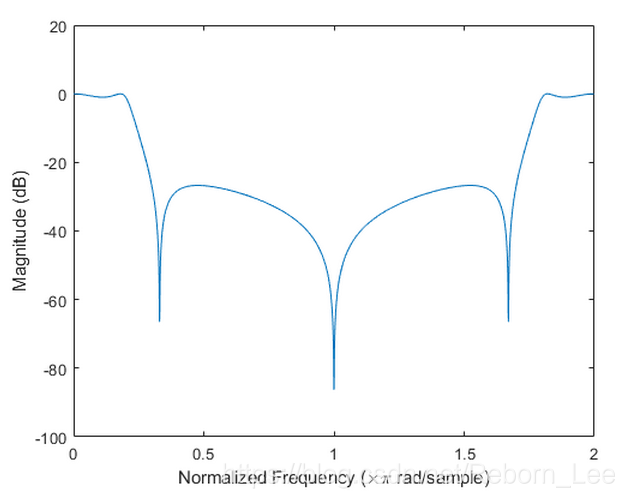freqz
Frequency response of digital filter
Syntax
[h,w] = freqz(b,a,n)
[h,w] = freqz(d,n)
[h,w] = freqz(___,n,'whole')
freqz(___)
[h,f] = freqz(___,n,fs)
[h,f] = freqz(___,n,'whole',fs)
h = freqz(___,w)
h = freqz(___,f,fs)
[h,w] = freqz(sos,n)
Description
[ returns the h,w] = freqz(b,a,n)n-point frequency response vector, h, and the corresponding angular frequency vector, w, for the digital filter with numerator and denominator polynomial coefficients stored in b and a, respectively.
[h,w] = freqz(b,a,n)返回数字滤波器的n点频率响应矢量h和相应的角频率矢量w,其中分子和分母多项式系数分别存储在b和a中。
[ returns the frequency response at h,w] = freqz(___,n,'whole')n sample points around the entire unit circle.
[返回整个单位圆周围的n个采样点的频率响应。h,w] = freqz(___,n,'whole')
Frequency Response from Transfer Function
Compute and display the magnitude response of the third-order IIR lowpass filter described by the following transfer function:

Express the numerator and denominator as polynomial convolutions. Find the frequency response at 2001 points spanning the complete unit circle.
clc;clear;close all;
b0 = 0.05634;
b1 = [1 1];
b2 = [1 -1.0166 1];
a1 = [1 -0.683];
a2 = [1 -1.4461 0.7957];
b = b0*conv(b1,b2);
a = conv(a1,a2);
[h,w] = freqz(b,a,'whole',2001);
% Plot the magnitude response expressed in decibels.
plot(w/pi,20*log10(abs(h)))
ax = gca;
ax.YLim = [-100 20];
ax.XTick = 0:.5:2;
xlabel('Normalized Frequency (\times\pi rad/sample)')
ylabel('Magnitude (dB)')

[ returns the h,w] = freqz(d,n)n-point complex frequency response for the digital filter, d.
Frequency Response of an FIR Bandpass Filter
Design an FIR bandpass filter with passband between and
rad/sample and 3 dB of ripple. The first stopband goes from 0 to
rad/sample and has an attenuation of 40 dB. The second stopband goes from
rad/sample to the Nyquist frequency and has an attenuation of 30 dB. Compute the frequency response. Plot its magnitude in both linear units and decibels. Highlight the passband.
sf1 = 0.1;
pf1 = 0.35;
pf2 = 0.8;
sf2 = 0.9;
pb = linspace(pf1,pf2,1e3)*pi;
bp = designfilt('bandpassfir', ...
'StopbandAttenuation1',40, 'StopbandFrequency1',sf1,...
'PassbandFrequency1',pf1,'PassbandRipple',3,'PassbandFrequency2',pf2, ...
'StopbandFrequency2',sf2,'StopbandAttenuation2',30);
[h,w] = freqz(bp,1024);
hpb = freqz(bp,pb);
subplot(2,1,1)
plot(w/pi,abs(h),pb/pi,abs(hpb),'.-')
axis([0 1 -1 2])
legend('Response','Passband','Location','South')
ylabel('Magnitude')
subplot(2,1,2)
plot(w/pi,db(h),pb/pi,db(hpb),'.-')
axis([0 1 -60 10])
xlabel('Normalized Frequency (\times\pi rad/sample)')
ylabel('Magnitude (dB)')
freqz(___) with no output arguments plots the frequency response of the filter.
Frequency Response of an FIR filter
Design an FIR lowpass filter of order 80 using a Kaiser window with . Specify a normalized cutoff frequency of rad/sample. Display the magnitude and phase responses of the filter.
b = fir1(80,0.5,kaiser(81,8));
freqz(b,1)

Design the same filter using designfilt. Display its magnitude and phase responses using fvtool.
d = designfilt('lowpassfir','FilterOrder',80, ...
'CutoffFrequency',0.5,'Window',{'kaiser',8});
freqz(d)
Note: If the input to freqz is single precision, the frequency response is calculated using single-precision arithmetic. The output, h, is single precision.
[ returns the h,w] = freqz(sos,n)n-point complex frequency response corresponding to the second-order sections matrix, sos.
[ returns the frequency response vector, h,f] = freqz(___,n,fs)h, and the corresponding physical frequency vector, f, for the digital filter with numerator and denominator polynomial coefficients stored in b and a, respectively, given the sample rate, fs.
[ returns the frequency at h,f] = freqz(___,n,'whole',fs)n points ranging between 0 and fs.
h = freqz(___,w)h, at the normalized frequencies supplied in w.
h = freqz(___,f,fs)h, at the physical frequencies supplied in f.